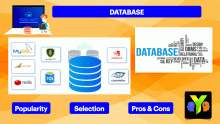Domain, Email, Service provider and Insight
Everyone in today's world have an email, it's good to extend our knowledge base about E-mail, domain name and service providers around these areas.

Today, I’ll be discussing a very simple, but it is of utmost important topic which plays a crucial role of running any business or activity, say my education website Young-Minds.sg
Your guess is bang on, I am talking about Domain name and associated email ID.
A Domain name is a unique string of characters that is used to identify a specific website on the internet. It is used to help users find and access a website, and it is also used by internet servers to route traffic to the correct web server.
Approximately 350 million domain names are registered as of 2021. Let’s me take you to some important terms linked with domain.
- DNS (Domain Name System) is a hierarchical naming system that is used to translate domain names into IP addresses. When a user enters a domain name in a web browser, the DNS system looks up the IP address associated with that domain name and sends the user to the correct web server.
- TLD (Top-Level Domain) is the highest level in the domain name system. It is the part of the domain name that comes after the dot (e.g. .com, .org, .net, .edu, .gov, etc.).
- gTLD (Generic Top-Level Domain) is a category of TLDs that are not restricted to any particular country or region. Examples of gTLDs include .com, .net, .org, .info, and .biz.
- FQDN (Fully Qualified Domain Name) is a domain name that includes the TLD, domain name, and any subdomains. For example, the FQDN for the website www.example.com would be www.example.com.
Here are some examples of domain names:
google.com (TLD: .com, gTLD: gTLD, FQDN: google.com)
nytimes.com (TLD: .com, gTLD: gTLD, FQDN: nytimes.com)
india.gov (TLD: .gov, gTLD: n/a, FQDN: india.gov.in)
harvard.edu (TLD: .edu, gTLD: n/a, FQDN: harvard.edu)
young-minds.sg (TLD: .sg, gTLD: n/a, FQDN: young-minds.com.sg)
Now we are sitting on a solid foundation, let me cover Domain and email service providers. It’s an indicative list.
There are many domain and email service providers out there, so it's difficult to narrow it down to just five. However, here are five popular options:
- Google Workspace (formerly G Suite)
- Microsoft 365 (formerly Office 365)
- Rediff Mail
- Zoho Mail
- GoDaddy
Setting up a domain and email service is relatively easy and can be done in just a few steps. First, you'll need to register your domain with a domain registrar, which is a company that manages the registration of domain names. Once you've registered your domain, you can set up email addresses associated with that domain using an email service provider.
The cost of domain and email services can vary depending on the provider and the features you need. Some providers offer basic email services for free, while others charge a monthly fee for more advanced features. Domain registration fees also vary, but they typically range from $10 to $15 per year.
In addition to domain and email services, many providers offer other services such as website hosting, website builders, and online storage solutions. Some also offer additional business tools like project management software and customer relationship management (CRM) tools.
When choosing a domain and email service provider, it's important to consider your specific business needs and budget, as well as the provider's reputation, security features, and customer support.
Let me extent the email topic to little deep to understand the email protocols that are used to send and receive email.
Domain Forwarding (CName Records) is a DNS record that allows you to redirect one domain or subdomain to another domain or subdomain. This means that when someone types in the original domain or subdomain, they will be automatically redirected to the new domain or subdomain.
POP, POP3, SMTP, IMAP, and IMAP4 are all email protocols that are used to send and receive email.
- POP (Post Office Protocol) is an email protocol used to retrieve email from a mail server. POP3 is the latest version of the protocol and is widely used today.
- SMTP (Simple Mail Transfer Protocol) is an email protocol used to send email between servers. It's the most commonly used email protocol on the internet.
- IMAP (Internet Message Access Protocol) is an email protocol that allows you to access and manage your email from multiple devices. It's similar to POP but offers more features and allows you to keep your email synced across different devices.
- IMAP4 is the latest version of the IMAP protocol and offers additional features such as server-side searching and improved security.









